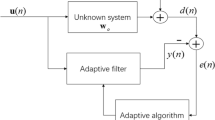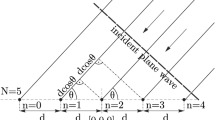Abstract
This paper addresses the problem of synchronous CDMA communications when, due to bandwidth limitations, signature waveforms have relatively large correlations. A receiver which uses the multiple received signals available from an antenna array is proposed and its performance analyzed. This receiver may be interpreted as a multichannel extension of the decorrelating detector and therefore shares its immunity to near-far effects. The receiver uses the discrimination afforded by the antenna array to effectively reduce the correlation between users' transmitted signals thereby avoiding the reduction in performance which occurs in the single channel decorrelator when signature correlations become significant.
Similar content being viewed by others
References
U. Madhow and M. Honig, Minimum mean squared error interference suppression for direct-sequence spread-spectrum codedivision multiple access, in Proc. 1st Int. Conf. Universal Personal Commun., 1992.
M. Abdulrahman, D. Falconer, and A. Sheikh, Equalization for interference cancellation in spread spectrum multiple access systems,Proc. VTC, May 1992.
R. Lupas and S. Verdú, Linear multiuser detectors for synchronous code-division multiple-access channels,IEEE Trans. Information Theory, Vol. 35, pp. 123–136, 1989.
R. Lupas and S. Verdú, Near-far resistance of multiuser detectors in asynchronous channels,IEEE Trans. Communications, Vol. 38, pp. 496–508, 1990.
R. Kohno, H. Imai, M. Hatori, and S. Pasupathy, Combination of an adaptive array antenna and a canceller of interference for direct-sequence spread-spectrum multiple-access system,IEEE Journal on Selected Areas in Communications, Vol. 8, pp. 675–682, 1990.
B. Suard, A. F. Naguib, G. Xu, and A. Paulraj, Performance of CDMA mobile communication systems using antenna arrays, inProceedings of the IEEE Intl. Conf. on Acoustics, Speech, and Signal Processing, Vol. IV, pp. 153–156, 1993.
S. Y. Miller and S. C. Schwartz, Integrated spatial-temporal detectors for asynchronous Gaussian multiple-access channels,IEEE Trans. Communications, Vol. 43, 1995, to appear.
Z. Zvonar and D. Brady, Suboptimum multiuser detector for synchronous CDMA frequency-selective Rayleigh fading channels, inProceedings of the IEEE Global Telecommunications Mini-Conference on Communications Theory, pp. 82–86, 1992.
A. Naylor and G. Sell,Linear Operator Theory in Engineering and Science, Springer-Verlag, New York, 1982, chap. 5.
R. A. Horn and C. R. Johnson,Matrix Analysis, Cambridge University Press, Cambridge, 1985, Chap. 7.
W. C. Lee,Mobile Communications Engineering, McGraw-Hill, New York, 1982, Chap. 6.
Author information
Authors and Affiliations
Rights and permissions
About this article
Cite this article
Brown, T., Kaveh, M. A decorrelating detector for use with antenna arrays. Int J Wireless Inf Networks 2, 239–246 (1995). https://doi.org/10.1007/BF01538148
Issue Date:
DOI: https://doi.org/10.1007/BF01538148




